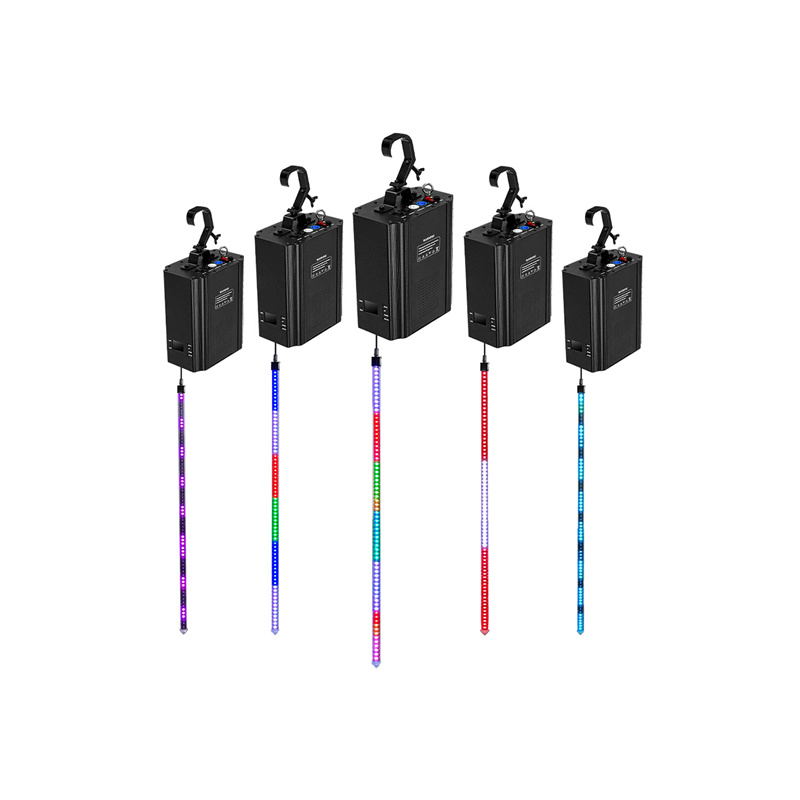Kinetic Tube Lighting for Stage, Club & Events | Dynamic LED Effects
Classification:
summary description]
What Is Kinetic Tube Lighting?
Imagine lights that don’t just shine—but move, dance, and breathe with the rhythm of sound and space. That’s kinetic tube lighting.
These aren’t your typical LED fixtures. Kinetic tube lights are suspended LED tubes, each mounted to a motorized winch, allowing them to move individually or in sync. Controlled via DMX or Art-Net, they glide vertically in dynamic patterns, changing color, pace, and position in real time. The result? A visually striking, immersive lightscape that feels alive.
Why the Buzz Around Kinetic Tube Lighting?
A New Dimension of Visual Art
Static lighting can be powerful, but kinetic lighting elevates things to another level. With motion as a key design element, kinetic tube lights can simulate waves, cascades, spirals, or even pixel-like animation grids. Whether it’s pulsing to a bass drop or gliding softly during a slower sequence, the effect is hard to ignore.
Maximum Impact, Minimal Footprint
Not every venue has space to spare. That’s where kinetic tubes shine. Hung vertically, they leave the floors open while creating an incredible visual above. You get depth, movement, and rhythm—without bulky setups or cluttered stage designs.
Complete Control at Your Fingertips
From subtle white fades to rapid-fire color chases, the control options are virtually limitless. These systems work with most industry-standard consoles and software, allowing lighting designers to create highly choreographed scenes that respond to audio cues or timed sequences.
Where You’ll Find Kinetic Tube Lighting in Action
Live Shows & Tours
Big-name concerts and music festivals are using kinetic tubes to craft unforgettable atmospheres. Picture hundreds of LED tubes rising and falling like ocean swells above a cheering crowd—it’s the kind of moment people remember.
Nightclubs & DJ Venues
In smaller indoor spaces, kinetic lights provide intensity without the bulk. Their programmable motion adds a tech-savvy edge, and when paired with strobes or lasers, they complete the club’s energy profile.
Exhibitions & Brand Activations
Need to make a bold first impression at a trade show? Suspended kinetic lights over a booth don’t just attract attention—they demand it. The movement invites people in and creates a perfect setting for immersive brand storytelling.
Architectural Installations
Kinetic tube lighting is also showing up in permanent spaces. From hotel lobbies to commercial atriums, it introduces a futuristic, kinetic element that feels modern and interactive.
What to Look for When Choosing a Kinetic Tube Lighting System
- Motor Quality: The motor is the heart of kinetic movement. Look for smooth, reliable winches with minimal noise.
- LED Type: High-brightness RGB or pixel-controlled LEDs offer a more creative range.
- Control Compatibility: DMX512 and Art-Net are industry standards, ensuring your lights can sync with existing systems.
- Customization: Need longer tubes, specific color temperatures, or low-voltage configurations? Many manufacturers offer custom builds.
- Rigging Requirements: Make sure your venue can support the overhead weight and installation layout.
Installation Tips for Maximum Effect
Start with a plan. Layout matters. Uneven spacing or poor calibration can ruin the symmetry and flow of motion. Work with a technician to align winch positions and map control channels correctly.
Test motion paths before showtime. Nothing kills a light show like lag or stuck fixtures. And don’t forget to double-check ceiling load ratings—you don’t want surprises during setup.
Lastly, integrate the system into your lighting console from the start. That way, kinetic lighting becomes part of the show, not just an add-on.
Looking Ahead: The Future of Kinetic Lighting
Expect more interactivity in the coming years. Developers are experimenting with motion-tracking tech that lets lights respond to audience movement in real time. Others are layering AI and sound analysis into their control systems, enabling kinetic lights to react more intuitively to live audio.
And as LED efficiency continues to improve, kinetic lighting becomes a more sustainable, long-term solution for both touring and fixed installations.
Why Designers and Organizers Are Making the Switch
The appeal is simple. Kinetic tube lighting transforms ordinary spaces into multi-dimensional canvases. It tells a story not just with light and color, but with motion and rhythm. For designers, that means more tools to create mood and emotion. For audiences, it means a deeper connection to the experience.
Whether you're planning a one-night show or designing a permanent space, kinetic tube lighting offers unmatched versatility and creative control.
Conclusion
Kinetic tube lighting isn’t just a trend—it’s a shift in how we think about visual storytelling. It blends technology, design, and emotion into a powerful lighting solution that adapts to any space or scenario. From concerts to architecture, it offers a living light performance that static fixtures simply can’t match.
FAQs
1. Are kinetic tube lights difficult to install?
Installation requires proper planning and ceiling rigging, but with professional support, setup is straightforward.
2. Can I program kinetic lights without a lighting console?
While possible, using a lighting console or dedicated software gives you much better creative control.
3. Are kinetic tube lights safe for public use?
Yes, as long as the system is installed correctly and maintained regularly.
4. What’s the average lifespan of a kinetic tube lighting system?
High-quality systems can last several years, especially with LED modules and durable motor parts.
5. Can I use kinetic tube lights with other effects like fog or lasers?
Absolutely. They’re often used alongside other effects for a layered visual experience.
Previous Page
More Cases


